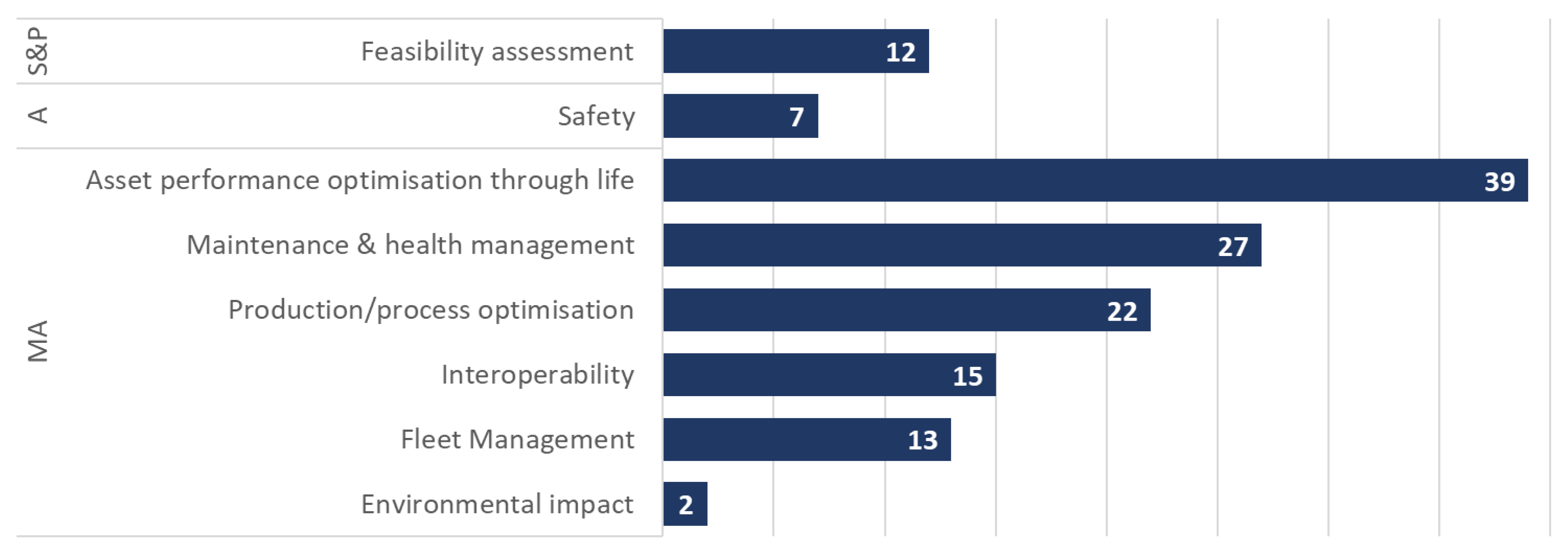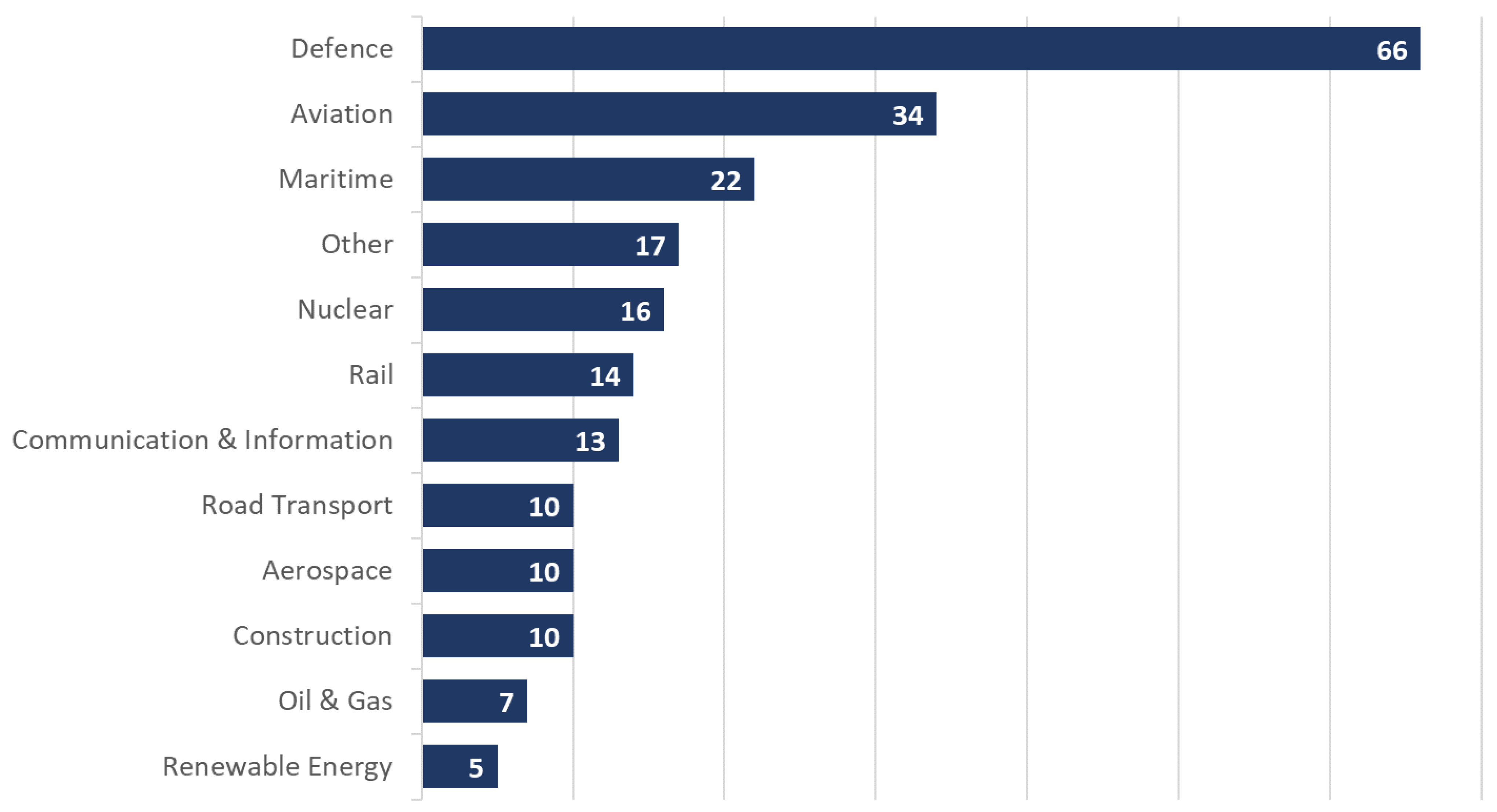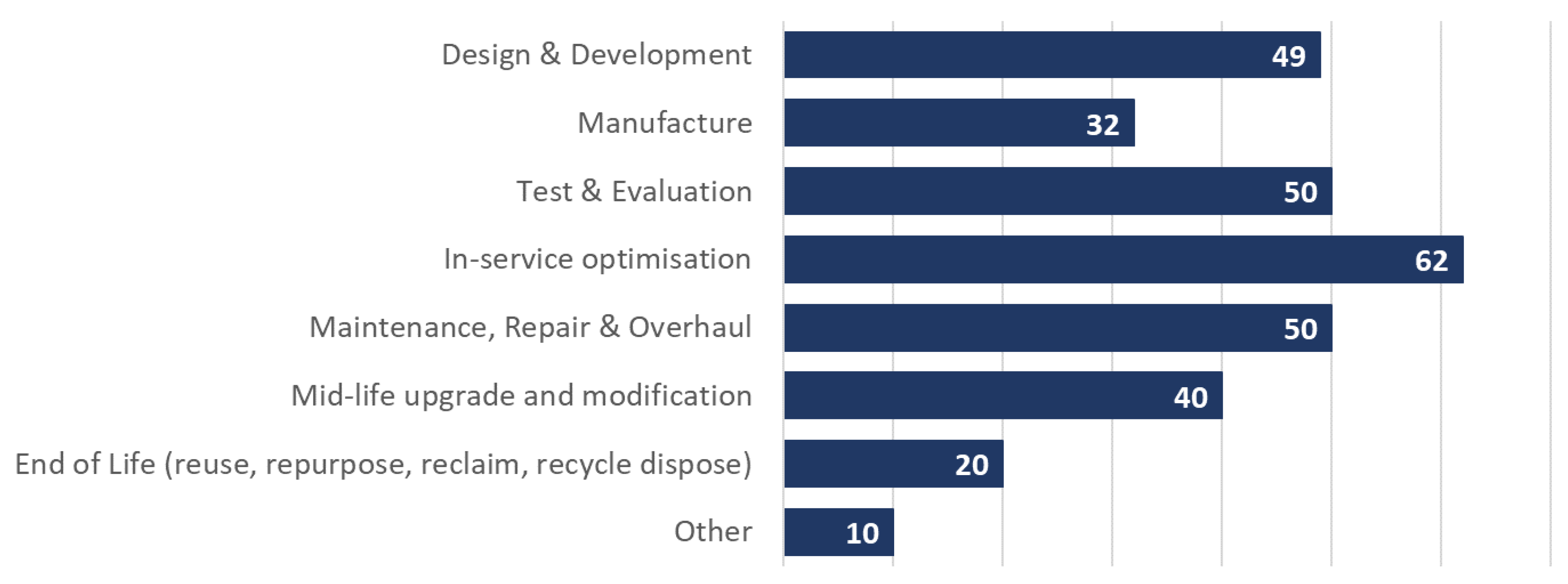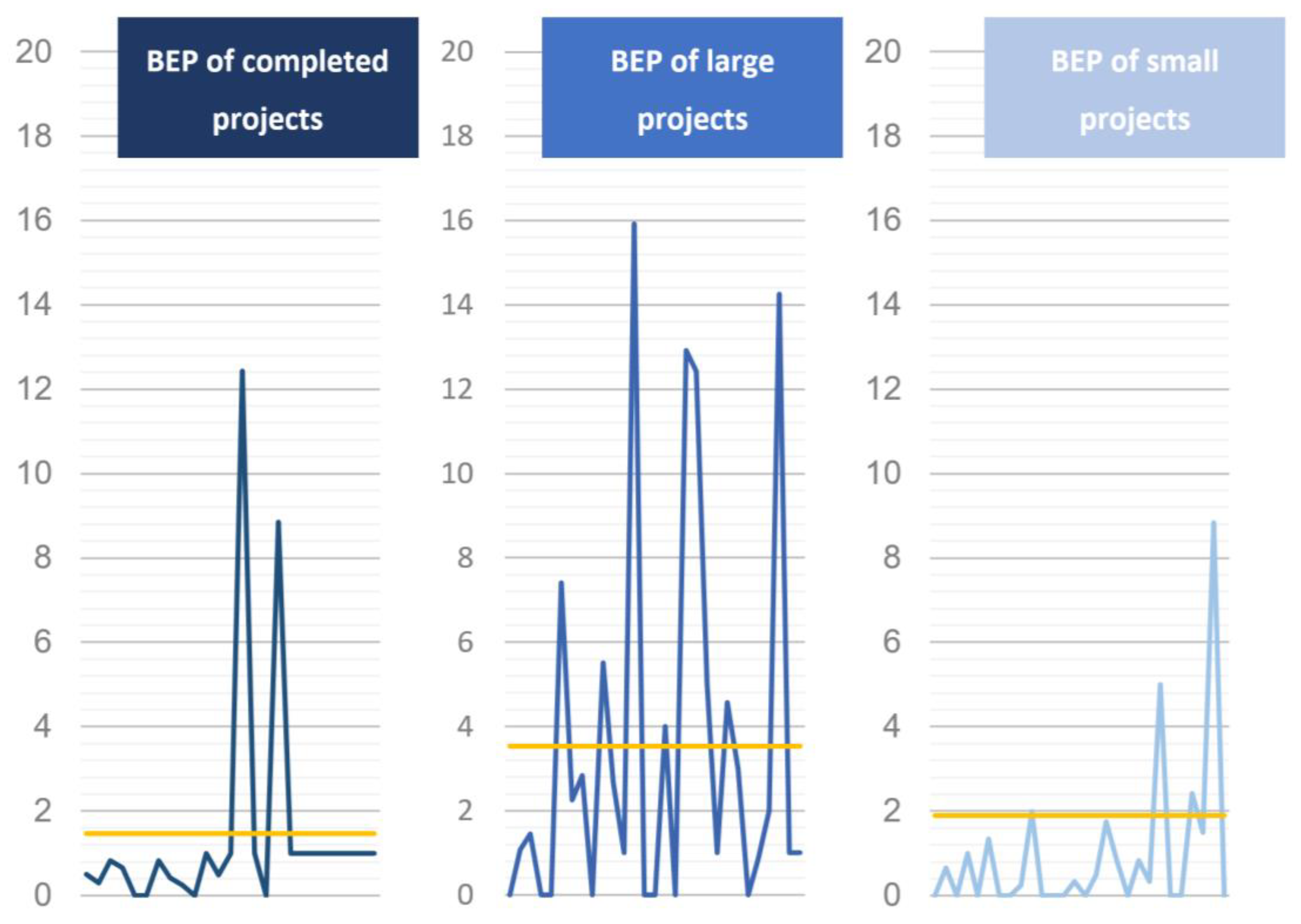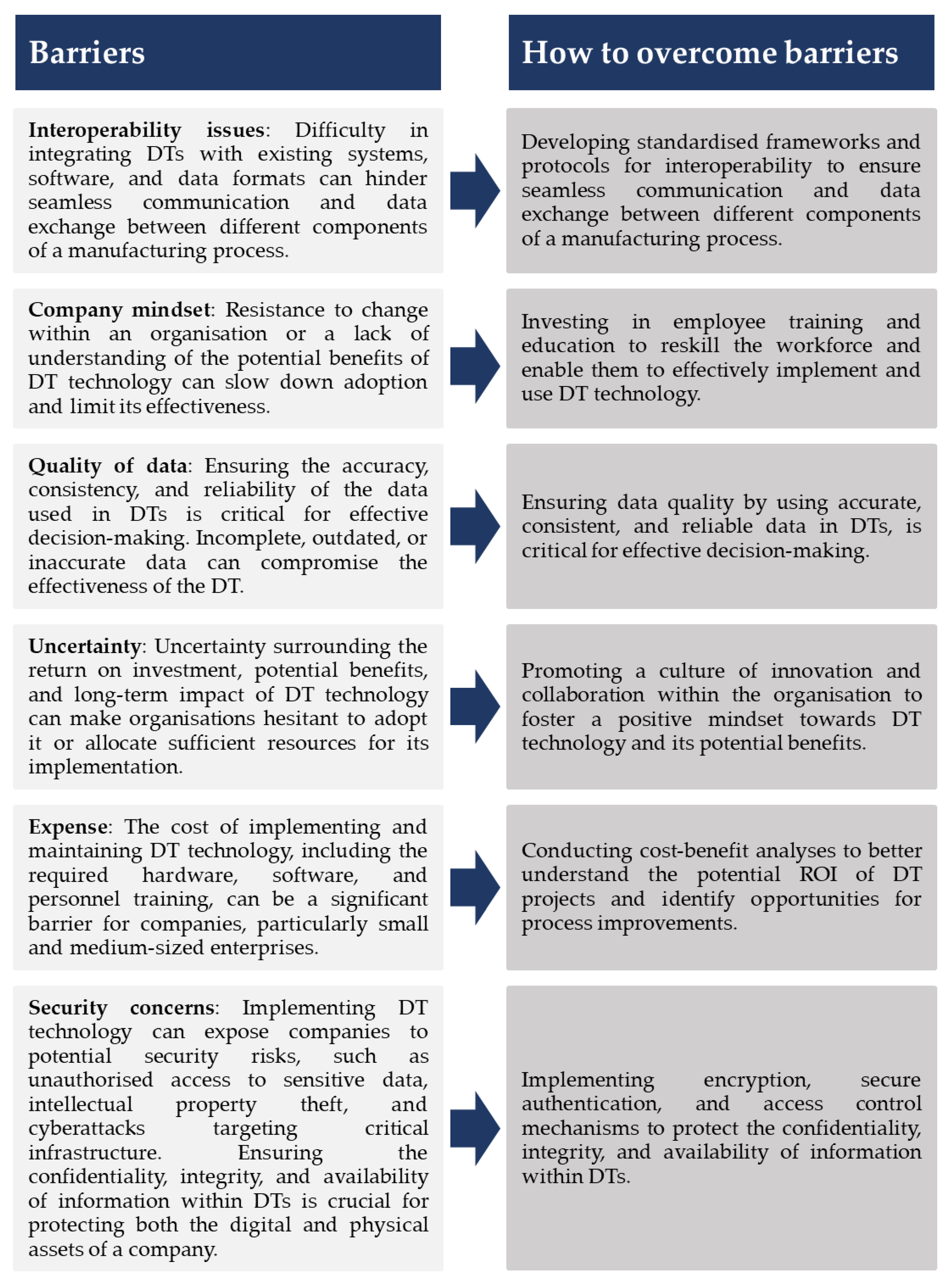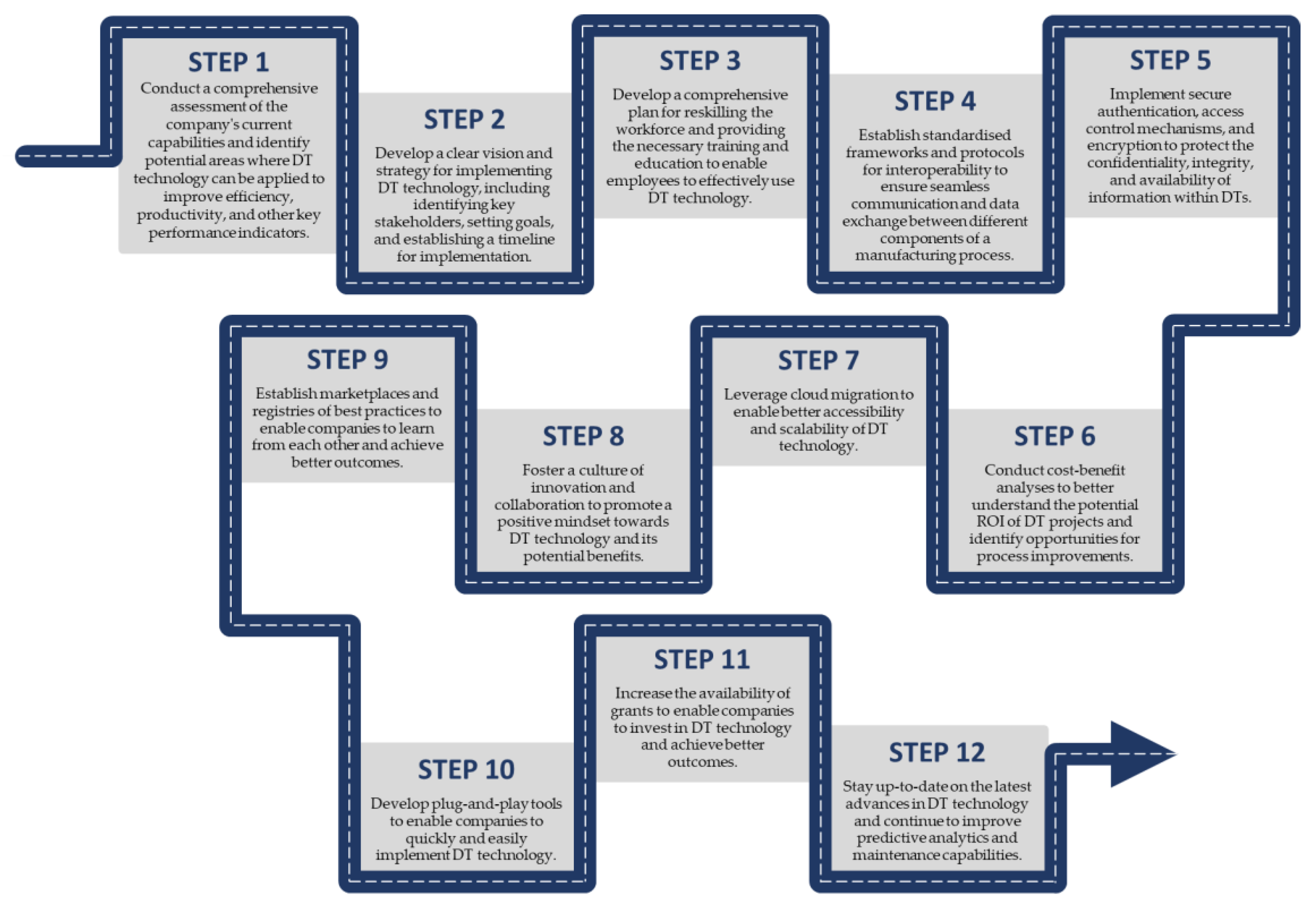1. Introduction
Digital twins (DTs) are becoming increasingly popular in the manufacturing industry as they offer the potential for the application of concepts like smart manufacturing, industry 4.0 [
1,
2], and digital factories [
3]. DTs are digital replicas of physical assets, which can be used to improve the speed, quality, and cost efficiency of manufacturing systems. They enable the simulation of production scenarios, allowing manufacturers to identify and resolve issues before they occur in the physical world. This is supported by studies like those of Biesinger, Kraß and Weyrich that show the potential of DTs in production planning [
4].
DT technology can also be applied from the early design phase of the product life cycle to improve the cost efficiency of asset management. This is supported by studies like Panarotto, Isaksson and Vial that show the benefits of DTs in the design phase [
5]. Additionally, DT technology is widely recognised for its ability to effectively support the maintenance of complex systems. Studies show that DTs can be used for real-time monitoring, maintenance prediction, and decision support for maintenance activities [
6]. Furthermore, DTs can be used for anomaly detection, as seen in studies like that of Calvo-Bascones et al. [
7]. They can also be used in combination with ontologies for failure detection [
8].
This study aims to examine the current state of DT usage in the industry through a mixed-methods exploration of the applications, drivers, inhibitors, properties, and future needs of DTs. Data were gathered from UK industry experts through a combination of an online survey and interviews, with a focus on the application areas, development process, investment requirements, lessons learnt, and future needs for DT development. The three research questions guiding this study are as follows:
What is the application landscape of DT in manufacturing?
What are the current practices in manufacturing?
What are the future needs?
The main contribution to knowledge is an insight into the current industry practices in the adoption of the DT paradigm, and the future steps and requirements. This paper provides experts’ points of view on the potential impacts of DT utilisation. This article also provides a summary of the challenges/barriers involved in the adoption of DT and how to overcome those, as well as a roadmap for the adoption of DT technology.
The authors focused on a broad catchment area with the survey. At this point, it was important to gather information from as many companies as possible and map out the present landscape of DT applications. The authors aimed to go deeper into understanding the DTs’ features, drives, inhibitors, and future requirements when conducting the interviews. The survey in the first phase was utilised to determine participants who were involved with DTs to capture their general understanding of the application landscape and the state of the project. As part of the survey, participants were invited to a second interview phase to capture specific knowledge on the DT projects they were associated with. Thus, for the second interview phase, only participants who agreed to disclose further information were involved in a semi-structured interview. This paper thus presents the outcomes from the survey together with the information captured as part of the interview phase. Care was taken to keep the information to a generic level due to the commercial sensitivity associated with the information shared. It must also be noted that the analysis and opinions presented do not represent any specific organisation and are based on the interpretation of the authors.
The methodology and the results have been divided into two sections, one dedicated to the online survey and one dedicated to the interviews, to separate and compare the results obtained from each data collection method. Therefore, the remainder of the paper is structured as follows:
Section 2 presents a literature review,
Section 3 presents the online survey methodology and related results,
Section 4 presents the methodology and results of the interviews,
Section 5 presents the discussion, and the conclusions are presented in
Section 6, including limitations and future works.
5. Discussion
The three main contributions are presented and answer the three research questions posed in the introduction section.
(1) What is the application landscape of DT in manufacturing? According to the sample analysed in this paper, DT projects are primarily applied in the defence, aviation, and maritime sectors. Their pivotal role spans different asset lifecycle phases such as in-service optimisation, maintenance, repair, and overhaul (MRO), and mid-life upgrades. Most DT projects, distributed fairly across small, medium, and large scales, focus predominantly on individual products (assets) rather than the broader systems they belong to, like supply chains. Financially, DT project returns typically materialise within two years for smaller projects and under four years for larger ones.
(2) What are the current practices in manufacturing? The process of designing DTs in manufacturing begins by determining the purpose and motivation of the DT. It also involves considering its elements, semantic properties, and visualisation attributes. Once the design process is established, the properties of DTs become critical. They include attributes such as portability, scalability, and interoperability, which directly influence their utility and effectiveness in the manufacturing processes.
On the financial side, the views on the use of DTs differ. Some companies utilise them as tools to identify hidden operational benefits, disregarding the need for a specific ROI for these projects. In contrast, others focus on the ROI and the BEP. This calculation can vary based on factors such as the industry, company size, and nature of the project.
(3) What are the future needs? Based on the results presented in the paper, the future needs for DT technology in manufacturing industries are as follows:
More focus on the system rather than just the product. The study found that the focus of DT technology has primarily been centred on the product (e.g., asset) rather than the system (e.g., processes) that consisted of, among other things, the supply chain. Thus, there is a need to shift the focus towards the system to achieve better outcomes.
Addressing the inhibitors of DT technology. The inhibitors of DT technology such as interoperability issues, the company’s mindset, complexity, quality of data, uncertainty, and expense need to be addressed to promote the implementation of DT technology in companies.
Achieving semantic interoperability between DTs. Semantic interoperability between DTs is a necessary step for building an ecosystem or federation of twins. This can be achieved through a “system of systems” approach.
Reskilling the team. There is a need to change the company’s mindset and reskill the team to enable the effective implementation and use of DT technology.
Cloud migration. There is a need for cloud migration to enable better accessibility and scalability of DT technology.
Marketplaces and registries of best practices. The need for marketplaces and registries of best practices can enable companies to learn from each other and achieve better outcomes.
Plug-and-play tools. The need for plug-and-play tools can enable companies to quickly and easily implement DT technology.
Grants. More grants can enable companies to invest in DT technology and achieve better outcomes.
Improving predictive analytics and maintenance capability in DTs. This can enable companies to optimise processes and achieve better outcomes.
Self-defining DTs. The concept of “self-defining DTs” could increase efficiency and effectiveness in the future.
Both in the survey and from the interviews, one of the aspects highlighted concerns the challenges and the barriers in DT development. The authors collected the main ones along with the solutions to overcome those barriers in
Figure 11.
Based on the findings presented in the paper, there is evidence to suggest that the use of DTs is likely to increase in the manufacturing industry. The study found that the majority of DT projects are in progress or completed, with an even distribution of sizes, and that the return on investment for DT projects was generally realised within two years for small projects and under four years for large projects. Furthermore, the paper highlights future needs for DT technology, including a focus on the system rather than just the product, achieving semantic interoperability between DTs, reskilling the team, cloud migration, marketplaces of best practices, plug-and-play tools, and improving predictive analytics and maintenance capability in DTs. These needs suggest that there is a growing interest in and recognition of the potential benefits of DT technology in the manufacturing industry and that efforts are being made to overcome some of the challenges identified in the study. Additionally, the increasing interest in the literature on DTs and their potential applications in various industries, including manufacturing, suggests that there is a growing awareness and understanding of the benefits of DT technology, which is likely to contribute to its increased use in the future.
The biggest impact of DT technology is likely to be made in improving efficiency and productivity in the manufacturing industry. The study found that DT projects were primarily focused on optimising the asset’s life cycle during operation, including in-service optimisation, MRO, and mid-life upgrade and modification, which can lead to better efficiency and productivity. Additionally, the study identified the properties of DTs, such as transparency, traceability, responsiveness, adaptability, and connectivity, as well as the financial aspects of DTs, such as ROI and BEP, as important considerations for their implementation. Addressing the challenges identified in the study, such as interoperability issues, mindset shifts, reskilling, and data focus, can also contribute to the successful implementation of DT technology and its impact on improving efficiency and productivity in the manufacturing industry.
By addressing these challenges, organisations can more effectively implement DT technology and leverage its potential benefits to improve efficiency, productivity, and other key performance indicators in the manufacturing industry.
One of the points that emerged in this paper is with regard to the current mindset of companies, which, from the authors’ perspective, is a hindrance to the development of DTs. This mindset needs to change for the development and progression of DTs. The current mindset of companies refers to the way companies currently approach the development and implementation of DTs. This can include a lack of understanding of the technology and its potential benefits, internal managerial and procedural issues, and a lack of necessary skills among team members. This mindset can act as a hindrance to the development of DTs, as it can limit the implementation, adoption and successful use of the technology.
The adoption of DT technology in the manufacturing industry can be a powerful catalyst for boosting efficiency, productivity, and optimising various other performance indicators. In order to achieve widespread adoption and maximise its potential benefits, a comprehensive and strategic roadmap has been proposed and illustrated in
Figure 12. The first step is to conduct a comprehensive assessment of the company’s capabilities and identify opportunities where DT technology can boost efficiency and productivity (Step 1). This is followed by the development of a clear strategy, including stakeholder identification, goal setting, and timeline establishment (Step 2). Then, the roadmap emphasises the importance of workforce reskilling to effectively utilise DT technology (Step 3), and the establishment of standardised frameworks for interoperability (Step 4). Secure information handling within DTs is also key (Step 5), as well as conducting cost–benefit analyses to comprehend the potential ROI from DT projects (Step 6). The latter part of the roadmap visualised in the figure highlights the role of cloud technology in improving DT technology accessibility and scalability (Step 7). It also underscores the value of fostering a culture of innovation and collaboration (Step 8) and the creation of best-practice marketplaces (Step 9). The final steps focus on the development of easy-to-implement tools for DT technology (Step 10), advocating for more grants (Step 11), and staying updated with DT technology advancements, particularly in predictive analytics and maintenance capabilities (Step 12).
6. Conclusions and Future Work
This paper aims to fill the gap in the literature about the current industrial practices of DTs. This paper addresses this gap by providing insights into the scientific literature about the application landscape, current practices, and future needs of DTs directly from the people who work and manage DT projects in the industry. Those insights have been extracted from the analysis of the results from an online survey and semi-structured interviews.
The key takeaways from this study on DT technology in the manufacturing industry include the following:
Growing interest and adoption. This study shows that there is an increasing interest in and adoption of DT technology in various sectors, such as defence, aviation, and maritime, with a focus on assets rather than systems.
Identified challenges. Interoperability issues, company mindset, complexity, data quality, uncertainty, expense, and security concerns are the primary challenges faced during the implementation of DT technology in the manufacturing industry.
DT properties and financial aspects. Key properties of DTs, such as transparency, traceability, responsiveness, adaptability, and connectivity, are essential considerations for their implementation. ROI and BEP are significant financial aspects that influence the adoption of DT technology.
Future needs and developments. This study identifies several future needs and potential developments in the field of DT technology, including a “system of systems” approach, semantic interoperability, mindset shifts, reskilling, data focus, cloud migration, marketplaces of best practices, plug-and-play tools, and improving predictive analytics and maintenance capabilities.
Roadmap for wider adoption. A strategic roadmap is proposed for the wider adoption of DT technology in the manufacturing industry, including steps such as conducting assessments, developing a clear vision and strategy, reskilling the workforce, standardising frameworks and protocols, implementing security measures, conducting cost–benefit analyses, and fostering a culture of innovation and collaboration.
Collaboration between industry and academia. This study highlights the importance of collaboration between industry and academia to advance the understanding and implementation of DT technology, leading to the development of best practices, innovative solutions, and the effective dissemination of knowledge.
One of the main needs arising from the interviews is the concept of the Federation of Twins. The authors have already published a systematic literature review about the concept of the Cognitive Digital Twin [
28]. The Cognitive DT concept is proposed as
a DT with augmented semantic capabilities for identifying the dynamics of the virtual model evolution, promoting the understanding of interrelationships between virtual models and enhancing the decision-making based on DT [
29]. The authors see the Cognitive DT model as one of the enablers and facilitators of the creation of the Federation of Twins. The semantic tools (such as ontologies and graph databases) bring to the DT a more human-like method [
30] of processing data and information. This article empowers the need for research in the field of cognitive DT, thus contributing to the field of cognitive computing.
However, this research is constrained by the limited sample size of companies surveyed, all of which were located in the UK and predominantly engaged in the defence sector. It is known that DT represents an innovation for many industries, and it is not yet extensively adopted; therefore, it is always difficult to find industries ready to invest time in this type of study. A more comprehensive study, employing a larger sample size and incorporating international representation, would yield a broader and more holistic perspective on the subject matter. Future research could encompass a wider array of companies and industries to assess the progress of ongoing projects and identify new initiatives that have emerged in the interim. This approach would facilitate the collection of more extensive data and insights into the current state and future potential of DT technology across various sectors and geographical locations.
It would be beneficial to conduct further investigation to assess the implementation of DTs across a broader range of companies. As the research progresses, it would be advantageous to delve deeper into the subject matter using a more balanced survey that encompasses all relevant sectors and enables cross-sectoral comparisons. Furthermore, subsequent rounds of surveys and interviews can be carried out to evaluate the progress of current DT projects and identify any new initiatives that have been launched. This would contribute to a more comprehensive understanding of the present state of DT implementation and its ongoing evolution.
This article yields numerous results that can be employed as a foundation for further research projects or to generate new investigative endeavours. The aspects of DTs highlighted in response to the third research question represent key areas that companies are keen to explore in the near future.

